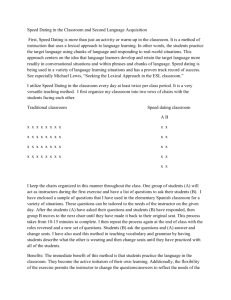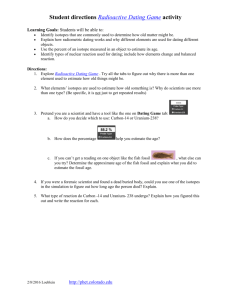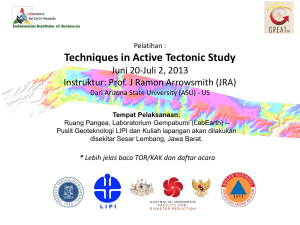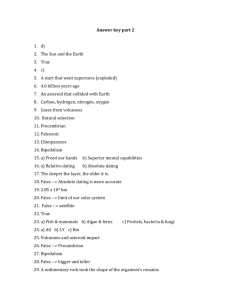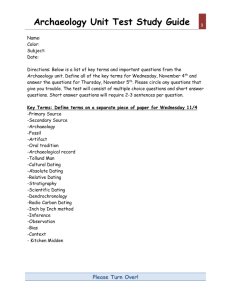Review Topics for Exam II
advertisement
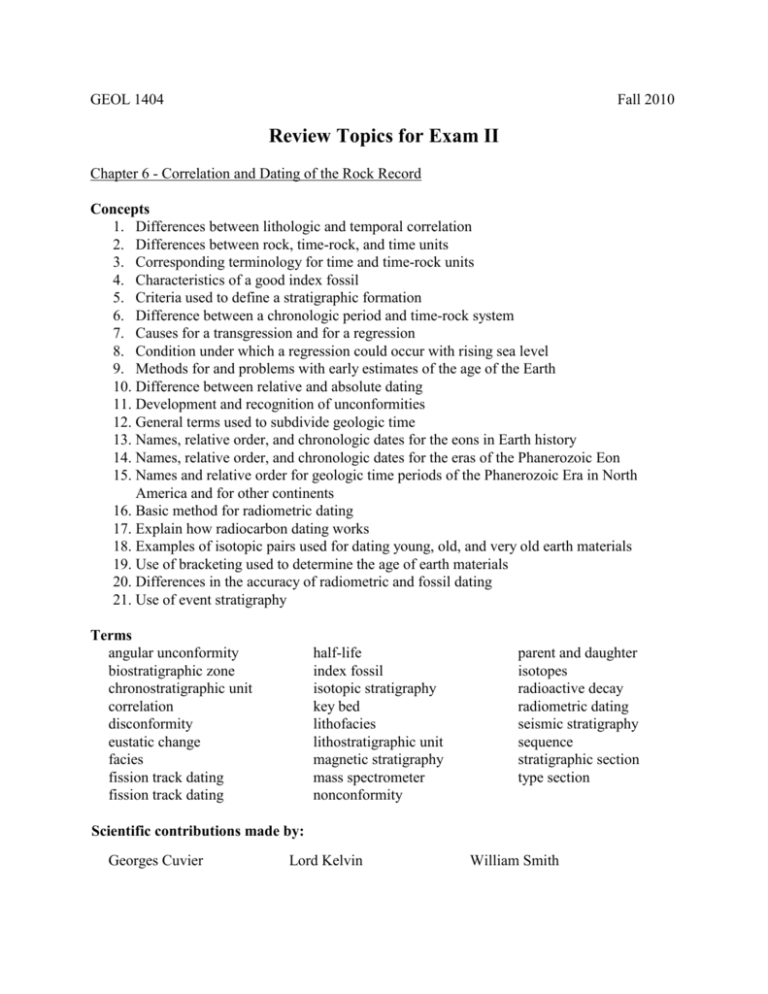
GEOL 1404 Fall 2010 Review Topics for Exam II Chapter 6 - Correlation and Dating of the Rock Record Concepts 1. Differences between lithologic and temporal correlation 2. Differences between rock, time-rock, and time units 3. Corresponding terminology for time and time-rock units 4. Characteristics of a good index fossil 5. Criteria used to define a stratigraphic formation 6. Difference between a chronologic period and time-rock system 7. Causes for a transgression and for a regression 8. Condition under which a regression could occur with rising sea level 9. Methods for and problems with early estimates of the age of the Earth 10. Difference between relative and absolute dating 11. Development and recognition of unconformities 12. General terms used to subdivide geologic time 13. Names, relative order, and chronologic dates for the eons in Earth history 14. Names, relative order, and chronologic dates for the eras of the Phanerozoic Eon 15. Names and relative order for geologic time periods of the Phanerozoic Era in North America and for other continents 16. Basic method for radiometric dating 17. Explain how radiocarbon dating works 18. Examples of isotopic pairs used for dating young, old, and very old earth materials 19. Use of bracketing used to determine the age of earth materials 20. Differences in the accuracy of radiometric and fossil dating 21. Use of event stratigraphy Terms angular unconformity biostratigraphic zone chronostratigraphic unit correlation disconformity eustatic change facies fission track dating fission track dating half-life index fossil isotopic stratigraphy key bed lithofacies lithostratigraphic unit magnetic stratigraphy mass spectrometer nonconformity parent and daughter isotopes radioactive decay radiometric dating seismic stratigraphy sequence stratigraphic section type section Scientific contributions made by: Georges Cuvier Lord Kelvin William Smith Chapter 7 – Evolution and the Fossil Record 1. Evidence for biological evolution 2. Viable reproduction 3. Relationship between DNA, genes, chromosomes, traits, and biological evolution 4. Descent with modification 5. The relationship between mutations and biological evolution 6. Causes for mutations 7. Sources of variation in a gene pool 8. Development of a new species 9. Concept and mechanisms of natural selection 10. Past and present evidence for mass extinctions 11. Overall trends in evolution 12. Types and examples of patterns in evolution 13. Graduated versus punctuated evolution 14. Use of a molecular clock in understanding evolution 15. Nature of the Quaternary mass extinction Terms Dollo’s Law gene gene pool homologous structure iterative radiation mutation adaptive radiation chromosome common ancestor convergent evolution Cope’s Rule deoxyribonucleic acid ontogeny phylogeny pseudoextinction sexual recombination trait vestigial organ Scientific contributions made by: Charles Darwin Gregor Mendel James Watson and Francis Crick Chapter 8 – The Theory of Plate Tectonics 1. Thickness and composition of a tectonic plate 2. Number of major tectonic plates 3. Evidence for continental drift 4. Process of sea floor spreading and evidence that it is taking place 5. Apparent polar wandering curves and their relation to continental drift 6. Differences in the three types of tectonic plate margins 7. Three basic types of geologic faults and differences in their motion 8. Origin and development of magnetic “stripes” on the seafloor 9. Describe the Wilson Cycle. 10. Evidence for subduction 11. Differences between oceanic and continental crust 12. Formation of forearc and foreland basins 13. Development of and location of mélange 14. Primary and less significant causes for the motion of tectonic plates 15. Fate of tectonic plates after subduction 16. Origin and location of mantle hot spots Terms accretionary wedge backarc declination forearc forearc basin Global Positioning System Glossopteris Gondwanaland graben guyot hot spot inclination island arc Laurasia lithosphere Scientific contributions made by: Alfred Wegener Alexander Du Toit mélange Mesosaurus ophiolite Pangaea strike-slip fault thrust fault transform fault Wilson cycle Harry Hess J. Tuzo Wilson Chapter 9 – Continental Tectonics and Mountain Chains 1. Differences between an active and passive continental margin 2. Process of continent-continent collision 3. Location and cause for failed rift arms 4. Features associated with continental rifts 5. Folds related to compression 6. Process by which overturned folds and thrust faults develop. 7. Location and development of a foreland basin 8. Formation and location of clastic wedges 9. Differences and location of flysch and mollasse 10. Origin and composition of ophiolite sequences 11. Cause and location for reversal of the direction of subduction 12. Relationship between the angle and rate of subduction 13. Mountain building by rifting 14. Location and development of structural domes and basins 15. Relationship between isostatic uplift and mountain building Terms anticline basin clastic wedge dome exotic terrane fold and thrust belt foreland basin isostasy molasse ophiolite orogeny paired metamorphic belt rifting suturing syncline tectonic suture terrane flysch triple junction




